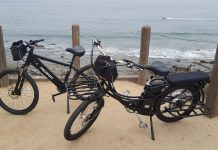Ahoy!
The boating season officially begins on this Memorial Day weekend and the weather is expected to be perfect for outdoor activities, with sunny skies and air temperatures in the 70s.
This busy boating weekend immediately follows the end of the National Safe Boating Campaign’s Safe Boating Week that boasts the motto “Wear It.” The goal of the campaign is to remind boaters to wear their personal floatation devices, commonly called the lifejacket.
Today’s boater has options for different types and styles of lifejackets that now make wearing a lifejacket feasible. In the past, we had only the orange, cloth covered, bulky, and uncomfortable lifejacket that smelled like mold from being stored in a damp locker. Now, we have a variety of designs that are comfortable and stylish – as much as a lifejacket can be stylish.
However, losing the bulkiness was a huge step in the right direction. Inflatable lifejackets brought in a new era. The two common styles are the belt pack and the suspender inflatable lifejackets that activated by submersion in water or yanking on a pull cord. I use a belt pack lifejacket that is in a small pouch with a pull cord, and I am thinking of including a personal strobe on the pouch, too.
Keep in mind that not all inflatable lifejackets are Coast Guard approved, so you will still need USCG approved lifejackets aboard the vessel. However, the inflatable can be the first line of immediate defense or response should you fall overboard or off the dock.
Tip of week is that the summer season is closing in rapidly on my radar, and June gloom will be here sooner rather than later. The hot daily inland temperatures pull in the cooler marine air, creating the low-lying clouds along the coast typically called the marine layer. It usually burns off by afternoon, but another byproduct of this weather condition is fog.
I mention fog on a regular basis because fog is a boater’s nightmare, especially when you are trying to enter an unfamiliar harbor while you are glued to your radar and the Global Positioning System. I regularly encounter fog on the Pacific while delivering yachts up and down the coast.
Boaters in the fog must be very careful when entering Newport or any other harbor, and consider the options. I frequently make a pre-sunrise stop in Morro Bay for fuel on my voyages, and many times, I have opted to wait outside the harbor entrance due to the thick fog. I wait until the sunrise gives us enough light to see the channel markers, or I follow a commercial fisherman who has the local knowledge.
When you encounter fog, what should you do? Just for fun, ask this question at one of the yacht clubs and count the wide array of answers. First and foremost, slow down so you can react within your visibility. There is not a set speed limit on the ocean, but the rules state that you must have your vessel under control. That means you must be able to identify and change course or stop to avoid a collision, so set your speed accordingly. A few neophytes will run at full throttle with limited visibility, so post a bow watch.
There are whistle signals for boaters in restricted visibility, and proper maritime nomenclature calls the vessel’s horn a whistle and a honk a blast. You may signal either a one-second “short” blast or a four- to six-second “prolonged” blast as the only two types of whistle blasts.
Here are four restricted visibility whistle signals, but boaters should review all the signals. In the fog, a vessel under power of an engine or motor may signal at least every two minutes one prolonged blast and listen for a response from a nearby vessel. Two prolonged blasts may be given by any vessel underway but not making way – engines not engaged or drifting. Vessels with limited or restricted maneuverability such as sailboats or towboats should signal one prolonged blast and two short blasts. If you are cruising near a commercial port, such as Long Beach or San Diego, you may hear four short blasts given by a pilot vessel waiting for a ship. That means there is a ship in the area, so stay alert and maybe you won’t hear the ship giving you the danger signal of five short blasts later.
Again, there are many signals, so please review the International versus Inland Waters regulations.
And don’t forget: Tune in to the No. 1 boating radio talk show in the nation, Capt. Mike Whitehead’s Boathouse Radio Show, broadcasting coast-to-coast on the CRN Digital Talk Radio syndicated network every Saturday at noon, Pacific Time and replayed on Sunday at 10 am Pacific. Join Chandler Bell and me as we talk about “all things boating.” You can find the station listings, cable TV channels, live streaming on the Internet, and now available are apps to listen to the show for your iPhone, Blackberry, iTouch, Android, Palm, and Windows Mobile at www.BoathouseTV.com or www.BoathouseRadio.com.
Until next week, Safe Voyages!




